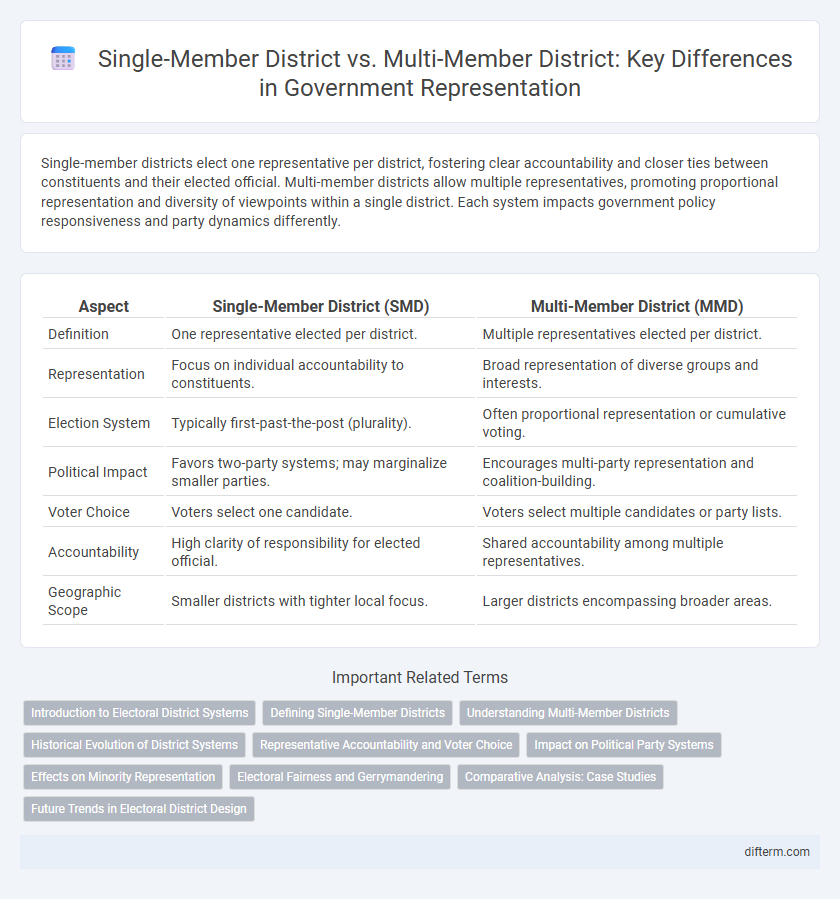Single-member districts elect one representative per district, fostering clear accountability and closer ties between constituents and their elected official. Multi-member districts allow multiple representatives, promoting proportional representation and diversity of viewpoints within a single district. Each system impacts government policy responsiveness and party dynamics differently.
Table of Comparison
| Aspect | Single-Member District (SMD) | Multi-Member District (MMD) |
|---|---|---|
| Definition | One representative elected per district. | Multiple representatives elected per district. |
| Representation | Focus on individual accountability to constituents. | Broad representation of diverse groups and interests. |
| Election System | Typically first-past-the-post (plurality). | Often proportional representation or cumulative voting. |
| Political Impact | Favors two-party systems; may marginalize smaller parties. | Encourages multi-party representation and coalition-building. |
| Voter Choice | Voters select one candidate. | Voters select multiple candidates or party lists. |
| Accountability | High clarity of responsibility for elected official. | Shared accountability among multiple representatives. |
| Geographic Scope | Smaller districts with tighter local focus. | Larger districts encompassing broader areas. |
Introduction to Electoral District Systems
Single-member districts elect one representative per district, promoting localized accountability and often leading to a two-party system. Multi-member districts elect multiple representatives, enabling proportional representation and fostering political diversity. These electoral district systems significantly influence legislative composition, voter engagement, and policy outcomes.
Defining Single-Member Districts
Single-member districts are electoral districts that elect one representative to a legislative body, ensuring direct accountability between the elected official and their constituents. This system simplifies voting by linking each voter to a single candidate, often promoting a stronger representative-constituent relationship. Compared to multi-member districts, single-member districts tend to produce clearer electoral outcomes and facilitate majority rule in government.
Understanding Multi-Member Districts
Multi-member districts elect multiple representatives from the same constituency, allowing for proportional representation and greater diversity in legislative bodies. This system contrasts with single-member districts, where only one representative is chosen per district, often leading to winner-take-all outcomes. Multi-member districts can enhance minority group representation and reduce the impact of gerrymandering by enabling broader voter expression within a single geographic area.
Historical Evolution of District Systems
Single-member districts originated in the 19th century, emphasizing localized representation by electing one representative per district, which strengthened accountability and direct voter-politician connections. Multi-member districts emerged earlier in various parliamentary systems, allowing for broader representation and proportional outcomes by electing multiple representatives per district. Over time, shifts between these district systems reflect evolving democratic priorities, with single-member districts dominating in the US and multi-member systems more common in proportional representation democracies.
Representative Accountability and Voter Choice
Single-member districts enhance representative accountability by linking one elected official directly to a specific constituency, making it easier for voters to hold their representative responsible for policy decisions. Multi-member districts increase voter choice by allowing the election of multiple representatives, which can lead to more diverse political viewpoints and better representation of minority groups. The trade-off between these systems involves balancing direct accountability with broader voter representation and electoral inclusiveness.
Impact on Political Party Systems
Single-member districts tend to encourage a two-party system by promoting winner-takes-all elections, which often marginalize smaller parties and limit political diversity. Multi-member districts, on the other hand, facilitate proportional representation, allowing multiple parties to gain seats and promoting a more pluralistic political landscape. This structural difference significantly influences party competition, electoral strategy, and overall political representation within government systems.
Effects on Minority Representation
Single-member districts tend to limit minority representation as candidates must secure a plurality in each district, often leading to majority dominance and underrepresentation of minority groups. Multi-member districts allow for proportional representation, increasing the likelihood that minority voices gain seats on councils or legislatures, promoting inclusivity and diversity. Studies show multi-member systems correlate with higher minority voter turnout and more equitable policy outcomes reflecting diverse community interests.
Electoral Fairness and Gerrymandering
Single-member districts often simplify representation but can exacerbate gerrymandering by enabling precise manipulation of electoral boundaries, reducing electoral fairness. Multi-member districts distribute representation more broadly, which can dilute the impact of partisan redistricting and enhance proportionality in election outcomes. However, the effectiveness of multi-member districts in preventing gerrymandering depends heavily on the electoral system design and implementation.
Comparative Analysis: Case Studies
Single-member districts, exemplified by the United States House of Representatives, typically produce stronger constituent-representative ties and clearer accountability, while multi-member districts, as seen in countries like Ireland with its single transferable vote system, enhance proportional representation and minority inclusion. Comparative analysis of these systems reveals that single-member districts often lead to two-party dominance, whereas multi-member districts facilitate multiparty representation and coalition governance. Case studies from Canada and Australia illustrate how multi-member districts can better reflect diverse electorates but may complicate voter choice and electoral accountability.
Future Trends in Electoral District Design
Future trends in electoral district design emphasize the growing adoption of multi-member districts to enhance proportional representation and voter diversity. Advances in data analytics and geographic information systems enable more precise boundary drawing, reducing gerrymandering risks in both single-member and multi-member districts. Governments increasingly explore hybrid models combining single-member accountability with multi-member inclusivity to balance local interests and overall electoral fairness.
Single-Member District vs Multi-Member District Infographic

 difterm.com
difterm.com